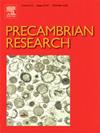Unravelling the Neoproterozoic oceanic sedimentary record: Insights from the Mona Complex Ocean Plate Stratigraphy, Wales
IF 3.2
2区 地球科学
Q2 GEOSCIENCES, MULTIDISCIPLINARY
引用次数: 0
Abstract
Ocean Plate Stratigraphy (OPS) represents a sequence of volcanic and sedimentary rocks of the uppermost part of an oceanic plate typically preserved in tectonic stacks of an accretionary wedge. While the characteristics of Phanerozoic OPS are generally well-known, those of Neoproterozoic OPS, especially their sedimentary components, remain underexplored. We combined field observations with petrography and geochemistry (major and trace elements, Sr–Nd isotopes) of sedimentary rocks from the Gwna Group (Mona Complex, Wales, UK) representing a well-preserved example of Neoproterozoic OPS. The rocks were subdivided into five groups: (1) red chert/jasper, (2) carbonate/dolostone, (3) black mudstone, (4) red/green mudstone, and (5) turbiditic/volcaniclastic rocks. The carbonate rock and red chert fill interpillow spaces or form less than 2-meter-thick layers above a basaltic base. These rocks formed as chemical precipitates from hydrothermal fluid (εNd = −2.4 to −1.2) or hydrothermally fluxed seawater (εNd = −8.3 to −7.4) related to magmatic activity on the seafloor. Unlike Phanerozoic OPS, the studied OPS does not include a thick bedded chert sequence resulting from the accumulation of plankton remains. The red, green, and black mudstones were deposited on the ocean floor in a pelagic or hemipelagic environment under oxygenated and anoxic conditions. They were predominantly sourced from distal mature continental crust as exemplified by their low εNd values (−11.3 to −3.5). In contrast, the turbiditic and volcaniclastic rocks (εNd = −1.9 to +0.8) that form most of the Gwna Group were sourced from an adjacent volcanic arc and deposited in a trench. We show that the OPS lithological and compositional changes relate to Neoproterozoic plate motion and increasing proximity to a subduction zone. The OPS of the Gwna Group serves as a crucial paleooceanographic and paleogeographic indicator in the Neoproterozoic.

求助全文
约1分钟内获得全文
求助全文
来源期刊

Precambrian Research
地学-地球科学综合
CiteScore
7.20
自引率
28.90%
发文量
325
审稿时长
12 months
期刊介绍:
Precambrian Research publishes studies on all aspects of the early stages of the composition, structure and evolution of the Earth and its planetary neighbours. With a focus on process-oriented and comparative studies, it covers, but is not restricted to, subjects such as:
(1) Chemical, biological, biochemical and cosmochemical evolution; the origin of life; the evolution of the oceans and atmosphere; the early fossil record; palaeobiology;
(2) Geochronology and isotope and elemental geochemistry;
(3) Precambrian mineral deposits;
(4) Geophysical aspects of the early Earth and Precambrian terrains;
(5) Nature, formation and evolution of the Precambrian lithosphere and mantle including magmatic, depositional, metamorphic and tectonic processes.
In addition, the editors particularly welcome integrated process-oriented studies that involve a combination of the above fields and comparative studies that demonstrate the effect of Precambrian evolution on Phanerozoic earth system processes.
Regional and localised studies of Precambrian phenomena are considered appropriate only when the detail and quality allow illustration of a wider process, or when significant gaps in basic knowledge of a particular area can be filled.
 求助内容:
求助内容: 应助结果提醒方式:
应助结果提醒方式:


